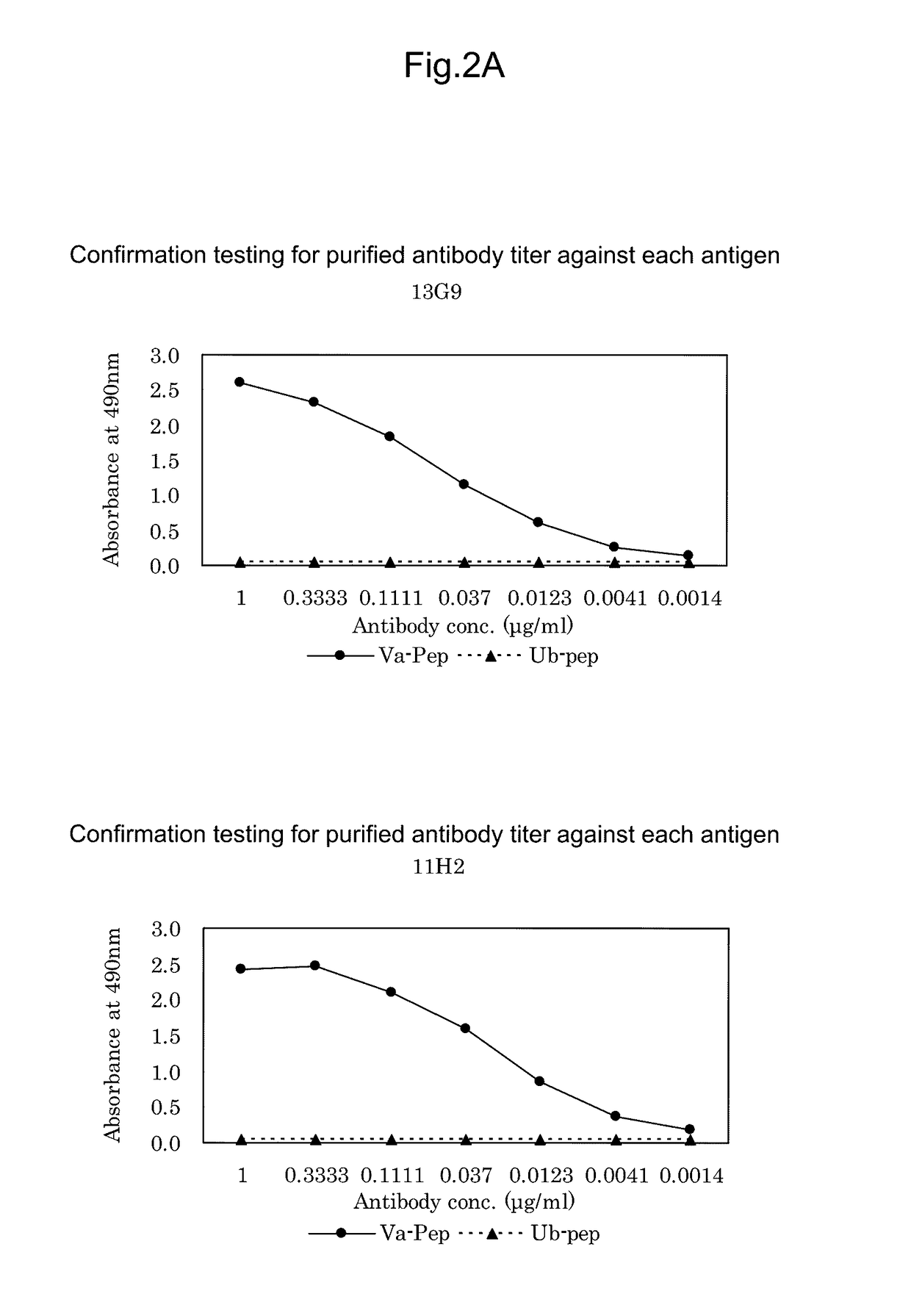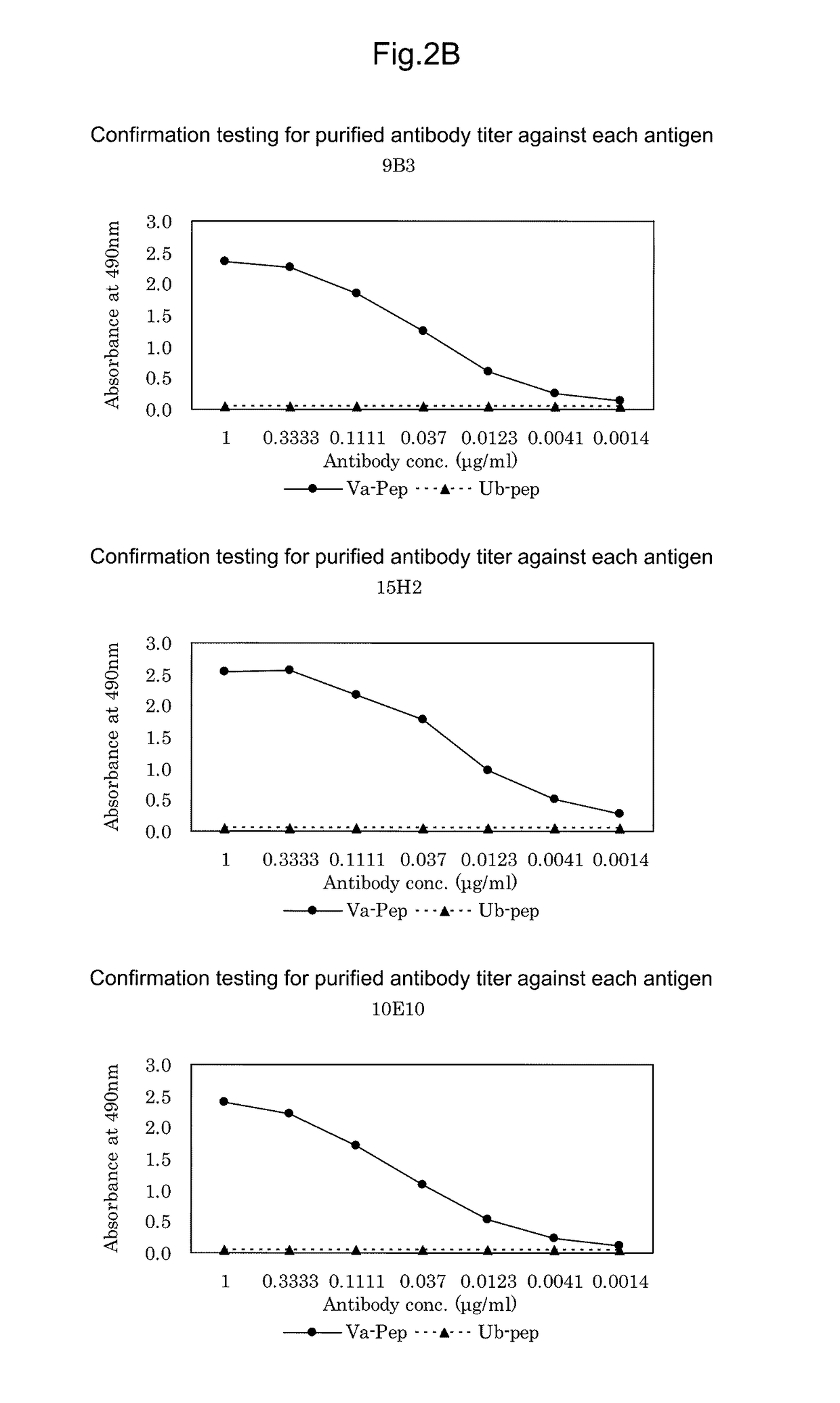Antibody against mutant α-actinin-4
a technology of -actinin and anti-mutant, which is applied in the field of anti-mutant -actinin4, can solve the problems of inability to apply surgical therapies to sclc, low detection efficiency of -actinin, and inability to achieve chemotherapeutic effects in non-sclc cases, and achieve high sensitive and specific detection of -actinin4
- Summary
- Abstract
- Description
- Claims
- Application Information
AI Technical Summary
Benefits of technology
Problems solved by technology
Method used
Image
Examples
example 1
Preparation of Monoclonal Antibody Specific to ACTN4-Va
(1) Preparation of Antigen
[0217]ACTN4-Va is expressed only in small cell lung cancer patient tissues or small cell lung cancer-derived cell lines, or in testis among normal tissues. Moreover, when attempting to prepare an immunizing antigen from these tissues or cell lines, the desired antigen site is any of three amino acids derived from amino acid sequence substitutions present in a novel splice variant. Thus, for use as an antigen to obtain the desired antibody, a tissue- or cell-derived antigen protein comprising the full-length sequence is not suitable as an immunizing antigen. For this reason, an immunizing antigen comprising a sequence with amino acid substitutions (SEQ ID NO: 4) was chemically synthesized as a partial peptide.
[0218]Then, the synthesized ACTN4-Va partial peptide was used as an immunizing antigen.
[0219]The synthesized peptide and KLH serving as a carrier protein were linked via disulfide bonds by the MBS m...
experimental example 1
Procedures for Antibody Screening
[0224]50 μL of ACTN4-Va peptide prepared at 1 μg / mL with PBS (pH 7.0) was added to each well of 96-well microtiter plates as an immobilized antigen and allowed to stand at 25 C for 1 hour. Concurrently, for confirmation of specificity, 50 μL of ACTN4-Ub peptide DIVNTARPDEKAIMTYVSS (SEQ ID NO: 3) was also added and allowed to stand at 25 C for 1 hour. Then, after washing three times with 0.05% Tween 20-containing PBS (pH 7.0) (PBST), 200 μL of 0.5% gelatin-containing PBST (blocking solution) was added to each well and then allowed to stand at 25 C for 1 hour. After washing, 50 μL of undiluted culture supernatants were added to the respective wells and allowed to stand at 25 C for 1 hour. Then, after washing three times with PBST, 50 μL of HRP-labeled anti-mouse IgG antibody (KPL) diluted 2500-fold was added to each well and allowed to stand at 25 C for 1 hour. Then, after washing three times with PBST, 100 μL of an o-phenylenediamine solution prepared...
experimental example 2
Procedures for Western Blotting-Based Screening and Specificity Confirmation
[0225]SDS-polyacrylamide electrophoresis (hereinafter referred to as SDS-PAGE) was conducted in the following manner, followed by Western blotting (hereinafter referred to as WB) through semidry blotting to conduct confirmation testing for specificity.
[0226]In the case of using extracts derived from cancer cell lines, the following three cell extracts were used as samples for specificity evaluation: human small cell lung cancer-derived cancer cell line H69 specifically expressing ACTN4-Va, as well as non-expressing lines, i.e., human pancreatic adenocarcinoma-derived cell line BxPC-3 and human breast cancer-derived cell line MCF7. In the case of using extracts derived from expressing cells, the following four cell extracts were used in total as samples for specificity evaluation: two types of transformed cells, i.e., HEK293 GFP-ACTN4-Va (transformed with ACTN4-Va) and HEK293 GFP-ACTN4-Ub (transformed with AC...
PUM
| Property | Measurement | Unit |
|---|---|---|
| average molecular weight | aaaaa | aaaaa |
| concentration | aaaaa | aaaaa |
| concentration | aaaaa | aaaaa |
Abstract
Description
Claims
Application Information
 Login to View More
Login to View More - R&D
- Intellectual Property
- Life Sciences
- Materials
- Tech Scout
- Unparalleled Data Quality
- Higher Quality Content
- 60% Fewer Hallucinations
Browse by: Latest US Patents, China's latest patents, Technical Efficacy Thesaurus, Application Domain, Technology Topic, Popular Technical Reports.
© 2025 PatSnap. All rights reserved.Legal|Privacy policy|Modern Slavery Act Transparency Statement|Sitemap|About US| Contact US: help@patsnap.com



